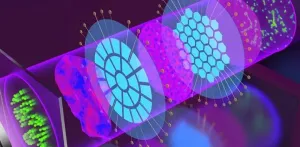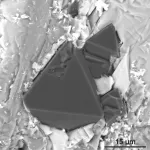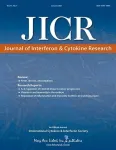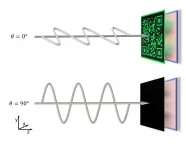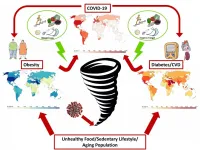(Press-News.org) BIRMINGHAM, Ala. - A 72-year-old woman was hospitalized with severe COVID-19 disease, 33 days after the onset of symptoms. She was suffering a prolonged deteriorating illness, with severe pneumonia and a high risk of death, and she was unable to mount her own immune defense against the SARS-CoV-2 virus because of chronic lymphocytic leukemia, which compromises normal immunoglobulin production.
But when physicians at the University of Alabama at Birmingham recommended a single intravenous infusion of convalescent blood plasma from her son-in-law -- who had recovered from COVID-19 disease -- a remarkable, beneficial change followed. Her physician, Randall Davis, M.D., professor in the UAB Department of Medicine, says she showed prompt and profound improvement within 48 hours.
Her 104-degree F fever rapidly dropped. In three days, the virus was no longer detectable in her respiratory swabs. And four days after the infusion, she was discharged from the hospital.
However, this single case appears to be an outlier, as shown through collaborative research at UAB, the University of Pennsylvania and several other institutions. In their study, reported in Cell Reports Medicine, researchers show that the woman's recovery was due to an extremely high virus-neutralizing titer in the son-in-law's donated plasma that she received. They found that this titer was higher than titers they measured in 64 other remnant convalescent plasmas collected by two blood banks.
Only 37 percent of the convalescent plasmas from the first blood bank had neutralizing antibody titers above 250, the lower cut-off value allowed by the Food and Drug Administration's emergency use authorization for convalescent plasma, which allows an unapproved medical product to be used in an emergency to treat life-threatening disease. In the plasmas from the second blood bank, only 47 percent exceeded the neutralizing antibody titer cut-off of 250. Thus, many of these plasmas were inadequate for transfusion.
While eight convalescent plasmas from the second blood bank exceeded a neutralizing antibody titer of 1,000, they were far beneath the extremely high, 5,720 neutralizing antibody titer of the son-in-law's plasma that was given to his immunodeficient COVID-19 mother-in-law.
The researchers also analyzed plasma titers in 17 other patients besides the 72-year-old woman, both before and after they were given convalescent plasma for treatment of COVID-19. Before infusion of plasma, 53 percent of these patients already had neutralizing antibody values greater than 250, and seven of the patients had titers greater than 3,000.
For the 16 patients the researchers were able to analyze, the infusion of convalescent plasma had no significant impact on their preexisting neutralizing antibody titers, and many of the recipients had endogenous neutralizing antibody responses that far exceeded those of the administered convalescent plasma units.
In contrast, the infusion of 218 milliliters of the son-in-law's convalescent plasma into the index COVID-19 patient, an amount equal to about one cup, resulted in an obvious rise in her neutralizing antibody titers that persisted four days after infusion.
"Our results have important implications for how convalescent plasma therapy is being used now and how it may be improved," Davis and colleagues reported. "The low neutralizing titers in most convalescent plasma donors raise concern.
"Convalescing individuals with truly high-titer neutralizing antibodies are rare, which underscores the need for a concerted effort to identify them but also poses the question of whether there are ample numbers of suitable convalescent plasma donors," they wrote. "The generally low neutralizing antibody titers in most donors, as well as high titer baseline neutralizing antibodies in many recipients, highlight the importance of first testing the convalescent plasmas, and also the recipients. Doing so should optimize the clinical benefit and reduce the effort spent when convalescent plasma therapy is not appropriate."
INFORMATION:
Co-first authors of the study are Kazuhito Honjo, DVM, Ph.D., UAB Department of Medicine, and Ronnie M. Russell, University of Pennsylvania Department of Medicine. Co-corresponding authors are Davis, UAB Department of Medicine, and Beatrice H. Hahn, M.D., University of Pennsylvania Department of Medicine.
Other authors are Ran Li, Edlue M. Tabengwa, Yutao Hua, Lynn Prichard, Sarah Sterrett, Todd P. McCarty, Paul A. Goepfert and Sonya L. Heath, UAB Department of Medicine; Weimin Liu and Regina Stoltz, University of Pennsylvania Department of Medicine; Ashton N. Kornbrust, Marisa B. Marques and Jose L. Lima, UAB Department of Pathology; Chris M. Lough, LifeSouth Community Blood Centers, Gainesville, Florida; Thomas J. Ketas and John P. Moore, Weill Medical College of Cornell University; Theodora Hatziioannou and Paul D. Bieniasz, The Rockefeller University, New York City; and David T. Redden, UAB Department of Biostatistics.
Support came from the UAB School of Medicine Dean's office COVID-19 research initiative, the UAB Cancer Immunobiology Program, and from National Institutes of Health grants AI069452, AI110553, AI036082 and AI150590.
Microscopy is the workhorse of contemporary life science research, enabling morphological and chemical inspection of living tissue with ever-increasing spatial and temporal resolution. Even though modern microscopes are genuine marvels of engineering, minute deviations from ideal imaging conditions will still lead to optical aberrations that rapidly degrade imaging quality. A mismatch between the refractive indices of the sample and its immersion medium, deviations in the thickness of sample holders or cover glasses, the effects of aging on the instrument--such deviations ...
Contemporary robots can move quickly. "The motors are fast, and they're powerful," says Sabrina Neuman.
Yet in complex situations, like interactions with people, robots often don't move quickly. "The hang up is what's going on in the robot's head," she adds.
Perceiving stimuli and calculating a response takes a "boatload of computation," which limits reaction time, says Neuman, who recently graduated with a PhD from the MIT Computer Science and Artificial Intelligence Laboratory (CSAIL). Neuman has found a way to fight this mismatch between a robot's "mind" and body. The method, called robomorphic computing, uses a robot's physical layout and intended applications ...
BOSTON - Regular aspirin use has clear benefits in reducing colorectal cancer incidence among middle-aged adults, but also comes with some risk, such as gastrointestinal bleeding. And when should adults start taking regular aspirin and for how long?
There is substantial evidence that a daily aspirin can reduce risk of colorectal cancer in adults up to age 70. But until now there was little evidence about whether older adults should start taking aspirin.
A team of scientists set out to study this question. They were led by Andrew T. Chan MD, MPH, a gastroenterologist and chief of the Clinical and Translational Epidemiology Unit at ...
Diamond, like graphite, is a special form of carbon. Its cubic crystal structure and its strong chemical bonds give it its unique hardness. For thousands of years, it has also been sought after as both a tool and as a thing of beauty. Only in the 1950s did it become possible to produce diamonds artificially for the first time.
Most natural diamonds form in the Earth's mantle at depths of at least 150 kilometres, where temperatures in excess of 1500 degrees Celsius and enormously high pressures of several gigapascals prevail - more than 10.000 times that of a well-inflated bicycle tyre. There are different theories for the exact mechanisms ...
The liquid electrolytes in flow batteries provide a bridge to help carry electrons into electrodes, and that changes how chemical engineers think about efficiency.
The way to boost electron transfer in grid-scale batteries is different than researchers had believed, a new study from the University of Michigan has shown.
The findings are a step toward being able to store renewable energy more efficiently.
As governments and utilities around the world roll out intermittent renewable energy sources such as wind and solar, we remain reliant on coal, natural gas and nuclear power plants to provide energy when the wind isn't blowing and the sun isn't shining. Grid-scale "flow" batteries are one proposed solution, storing energy for later use. But because they aren't very efficient, ...
New Rochelle, NY, January 20, 2020--SARS-CoV-2, the virus that causes COVID-19, blocks the processes of innate immune activation that normally direct the production and/or signaling of type I interferon (IFN-I) by the infected cell and tissues. IFN-I is a key component of host innate immunity that is responsible for eliminating the virus at the early stage of infection, as summarized in a recent review article in Journal of Interferon & Cytokine Research (JICR). By suppressing innate immunity, the virus replicates and spreads in the body unchecked, leading to the disease known as COVID-19. Click here to read the article now.
"SARS-CoV-2 utilizes various approaches to evade host IFN-I response, including suppression of IFN-I ...
Even a modest sea level rise, triggered by increasing global temperatures, would place 100 airports below mean sea level by 2100, a new study has found.
Scientists from Newcastle University modelled the risk of disruption to flight routes as a result of increasing flood risk from sea level rise.
Publishing the findings in the journal Climate Risk Management, Professor Richard Dawson and Aaron Yesudian of Newcastle University's School of Engineering analysed the location of more than 14,000 airports around the world and their exposure to storm surges for current and future sea level. The researchers also studied airports' pre-COVID-19 connectivity and aircraft traffic, and their current level of flood protection.
They ...
A brain pressure disorder that especially affects women, causing severe headaches and sometimes permanent sight loss, has risen six-fold in 15 years, and is linked to obesity and deprivation, a new study by Swansea University researchers has shown.
Rates of emergency hospital admissions in Wales for people with the disorder were also five times higher than for those without.
The condition is called idiopathic intracranial hypertension (IIH). It causes increased pressure in the fluid surrounding in the brain. This can lead to severely disabling headaches as well as vision loss, which ...
Despite the anticounterfeiting devices attached to luxury handbags, marketable securities, and identification cards, counterfeit goods are on the rise. There is a demand for the next-generation anticounterfeiting technology - that surpasses the traditional ones - that are not easily forgeable and can hold various data.
A POSTECH research team, led by Professor Junsuk Rho of the departments of mechanical engineering and chemical engineering, Ph.D. candidates Chunghwan Jung of the Department of Chemical Engineering and Younghwan Yang of the Department of Mechanical Engineering, have together succeeded in making a switchable display device using nanostructures that is capable of encrypting full-color images depending on the polarization of light. These findings were recently published in ...
In a Nature Reviews Endocrinology article authors from the German Center for Diabetes Research (DZD) highlight the interconnection of obesity and impaired metabolic health with the severity of COVID-19. First, they provide information about the independent relationships of obesity, disproportionate fat distribution and impaired metabolic health with the severity of COVID-19. Then they discuss mechanisms for a complicated course of COVID-19 and how this disease may impact on the global obesity and cardiometabolic pandemics. Finally, they provide recommendations for prevention and treatment in clinical practice and in the public health sector to combat these global pandemics.
Norbert Stefan, Andreas Birkenfeld and Matthias Schulze summarize ...

